For decades one of the first board games that most children play is the classic game Candy Land (Candyland). Probably part of the game’s success comes from the fact that is is such a straightforward game. The game was designed with young children in mind. The game board features colorful graphics and simple gameplay that helped reinforce color recognition and basic gameplay skills. With how long Candy Land has been in production, it has a pretty interesting history.
While Candy Land is mostly just a children’s game, it has stood the test of time. It still remains popular almost 75 years later. In this post I want to look at the history of Candy Land to see how it has changed over the years. While many aspects of Candy Land have remained the same since the beginning, there have actually been a surprising number of changes to the game in its history.
In this look at the history of Candy Land I will include pictures of the versions of Candy Land that I have access to. Unfortunately I don’t have access to some of the oldest versions of the game. I was able to see examples of the oldest versions of Candy Land though, to see how it changed during its early years.
1949 The Creation of Candy Land
The history of Candy Land begins in 1948. The world was dealing with a Polio epidemic. While in a hospital recovering, Eleanor Abbott (a teacher) created the game to give the children who were dealing with Polio something to keep their minds busy. Eventually she sold the game to Milton Bradley. Milton Bradley would own the rights to Candy Land until Hasbro acquired them in 1984.
There are many good sources of how Candy Land was first created. Check out the Wikipedia page or this YouTube video for more information about how the game was first created.
Basically the premise of Candy Land is to reach the castle at the end of a long path. Players take turns drawing a card. Each card features a color or a picture. If you draw a picture card you move your playing piece to the corresponding spot on the game board. If you draw a color, you will move to the next space on the path that matches the color. Finally if you draw a double color, you will move forward to the second closest space of the color you drew. The ultimate goal of the game is to be the first player to reach the castle. For the full rules check out my Candy Land how to play guide.
When most people think of Candy Land they think of characters such as King Kandy, Plumpy, Jolly, Queen Frostine, Mister Mint, Gloppy, Lord Licorice, Princess Lolly, and so on. None of these characters were actually present for the first version of Candy Land. In fact they wouldn’t come around for several decades.
Instead the original Candy Land board mostly just focused on a journey through a land of candy. The original version of the game featured locations such as the Candy Hearts, the Peppermint Stick Forest, the Ginger Bread Plum Tree, Gumdrop Mountains, Crooked Old Peanut Brittle House, the Ice Cream Floats, Lolli Pop Woods, and the Molasses Swamp. Your journey ends at an old cabin unlike the castle from future versions of the game. The only two characters in the game are a boy and a girl at the start of the trail. These characters were meant to represent the players. They would remain in the game for decades although their appearance would change.
Unlike later versions of the game, the playing pieces were normal player pawns. The game quickly replaced them with the gingerbread playing pieces used in most versions of Candy Land. The original board was longer than the current board. The board had 180 spaces compared to the 130-140 spaces of modern boards.
Candy Land’s Cosmetic Changes of the 1950s to 1970s
After its introduction in the late 1940s, Candy Land became a big hit. The initial version of the game sold for a few years with only some very minor changes.
In the 1950s the second main version of Candy Land was released. This version of the game features three children looking at a candy cabin along the left side, with the game’s title along the right side. The third main version of Candy Land released in 1956 and featured two children and a gingerbread man in front of a cabin. Additional versions of the game were released in 1962 and 1965.
These versions of the game barely changed the gameplay from the original Candy Land. The layout of the board slightly changed. The biggest change was the number of spaces being cut to 134.
In this period of Candy Land’s history the main differences came from changes to the artwork. The original game used a more cartoony visual style. The 1950s through 1970s boards tried to implement a more realistic art style.
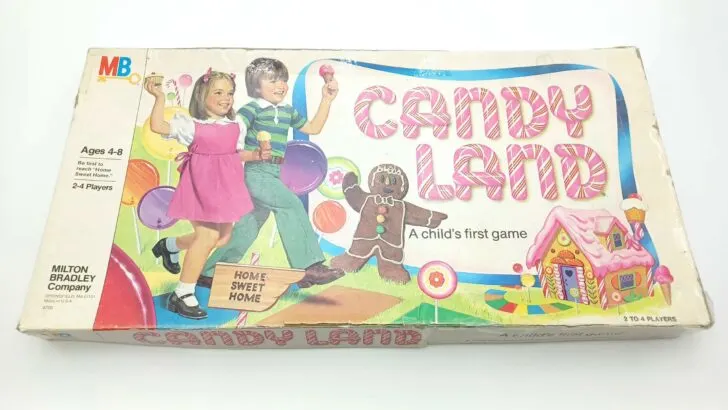
1978 The Last Candy Land Board Without Characters
For much of the 1970s Candy Land didn’t change much. In 1978 a new version of the game was released. This version of the game features a boy and girl walking towards a candy cabin with ice cream in their hands. A gingerbread man is also pointing towards the cabin.
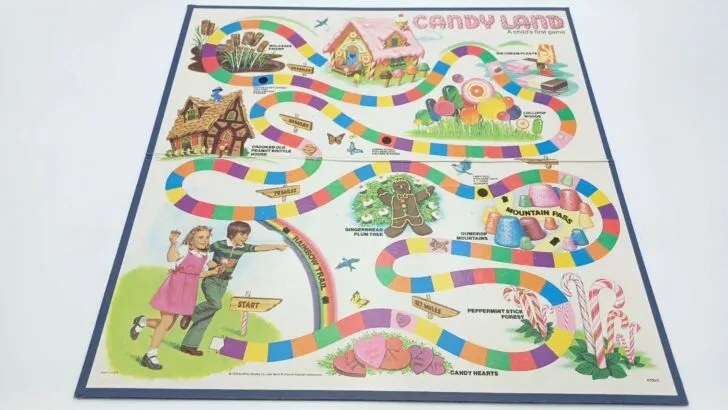
Like the 1950s and 1960s, the gameplay didn’t really change in the 1978 version of the game. The order of the colors and the positions of some of the spaces changed slightly. The only somewhat significant change is that one of the Cherry Pitfall spaces was changed to a Taffy Pull space.
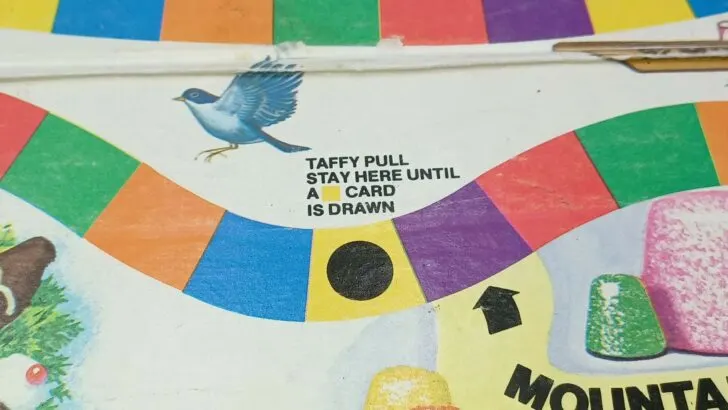
Otherwise the 1978 version of the game kept a similar cartoony yet realistic art style like the previous versions of the game.
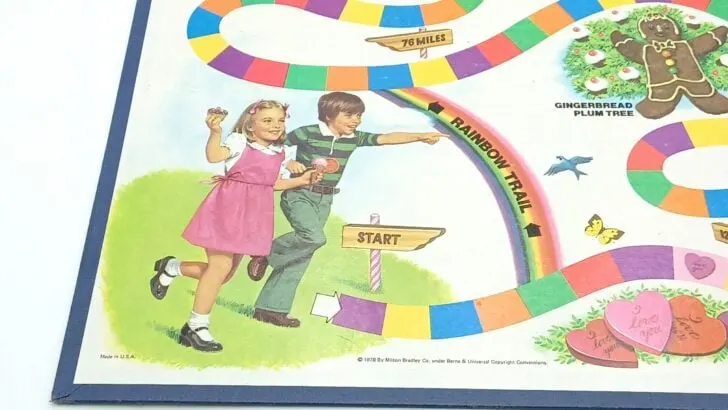
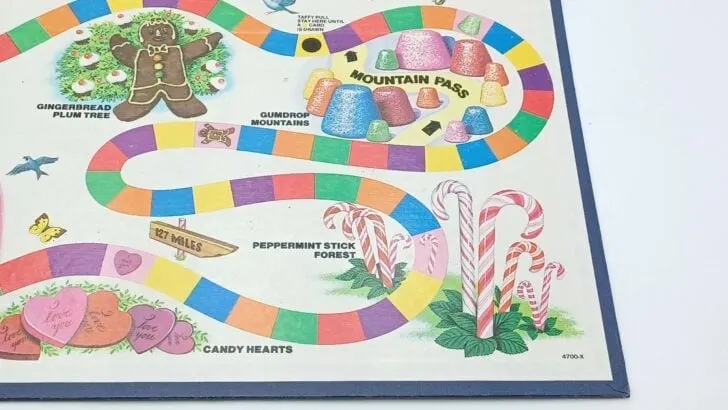
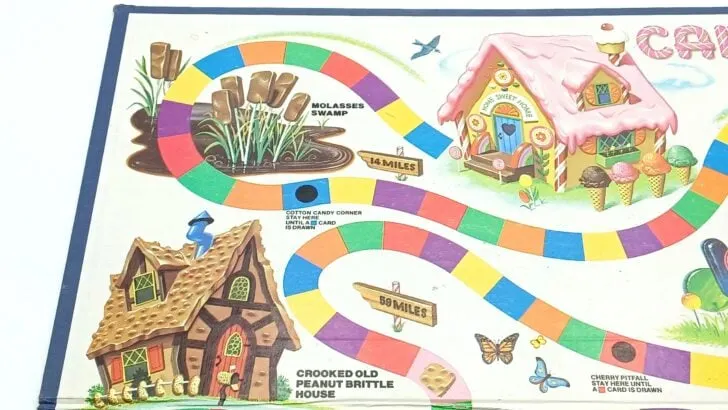
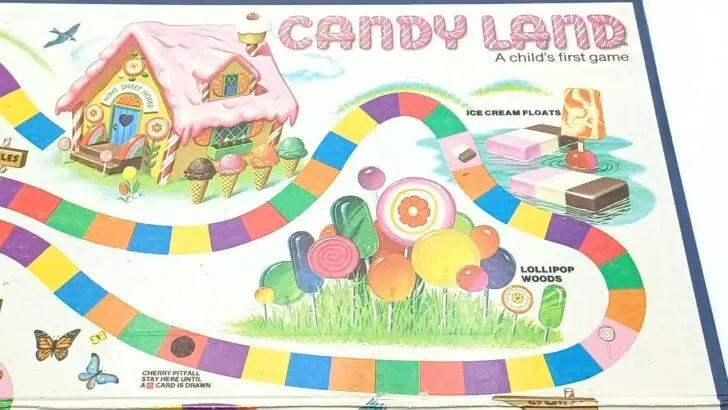
This version of Candy Land comes with 64 cards and four gingerbread movers.
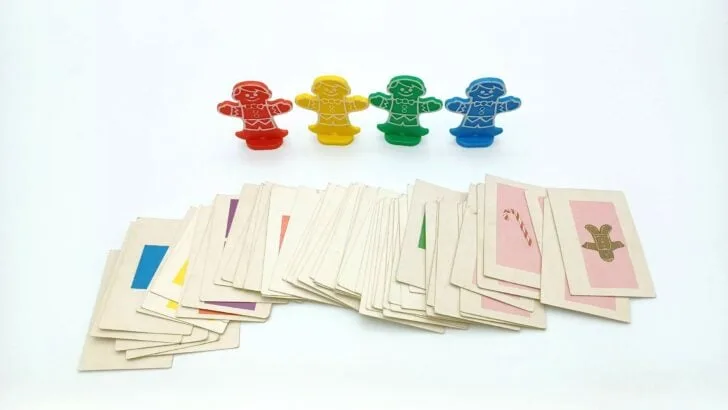
The distribution of the cards are as follows. Note my copy only had 61 of the 64 cards. There are three additional cards in the 1978 version of the game that are unaccounted for in this list.
- 7 blue cards
- 7 green cards
- 7 orange cards
- 7 purple cards
- 8 red cards
- 7 yellow cards
- 2 double blue cards
- 1 double green cards
- 2 double orange cards
- 2 double purple cards
- 2 double red cards
- 2 double yellow cards
- 7 special icon cards
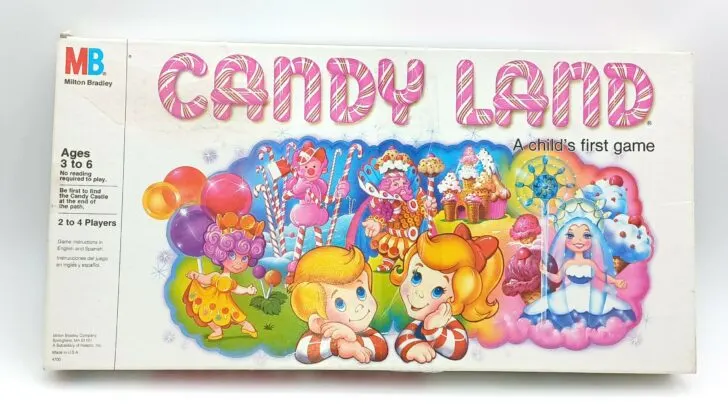
1984 The Introduction of the Classic Candy Land Characters
The 1984 version of Candy Land (which extended into the mid 1990s) is actually one of the most well known versions in the game’s history. This is the version of the game that I remember playing as a kid.
The 1984 version of Candy Land distinguishes itself as the first version of the game since the original to actually make a pretty big change. The gameplay for the most part remained the same. The game features 134 spaces. One of the special icon spaces was removed (corresponding to the Gingerbread Plum Tree). The order of the colors also changed.
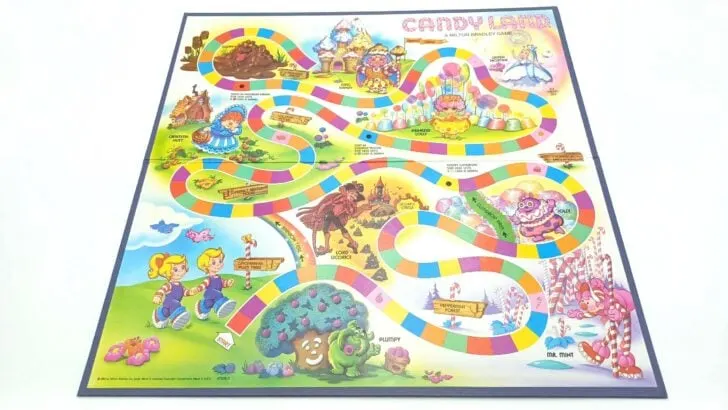
Most of the changes in the 1984 version of the game come from the theme of the game. After a few decades of using a more realistic art style, the game went back to a more cartoony style. Several of the locations around the board also ended up changing.
- The Peppermint Stick Forest became the Peppermint Forest.
- The Gingerbread Plum Tree was eliminated entirely and replaced with the Licorice Castle.
- Gooey Gumdrops replaced the Taffy Pull space.
- The Crooked Old Peanut Brittle house just became the Peanut Brittle House.
- The Cherry Pitfall space became Lost in Lollipop Woods.
- The Ice Cream Floats became the Ice Cream Sea.
- Finally the Cotton Candy Corner became Stuck in Molasses Swamp.
Probably the biggest change was the addition of characters and a story to Candy Land. There was now a plot as you had to make it to the castle in order to find King Kandy. Along the way you meet a number of characters that many people have fond memories of. You meet Plumpy the last of the PlumpaTrolls who is in charge of harvesting plums from the Gingerbread Plum Trees. Next comes Mr. Mint the lumberjack of the Peppermint Forest. As you round the bend you meet Lord Licorice at the Licorice Castle. Lord Licorice is responsible for King Kandy’s disappearance.
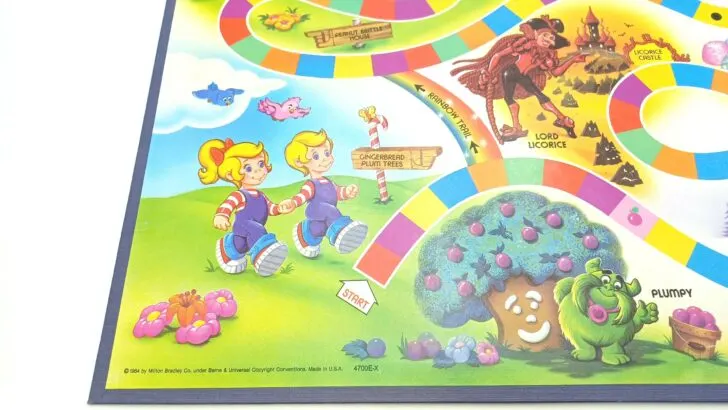
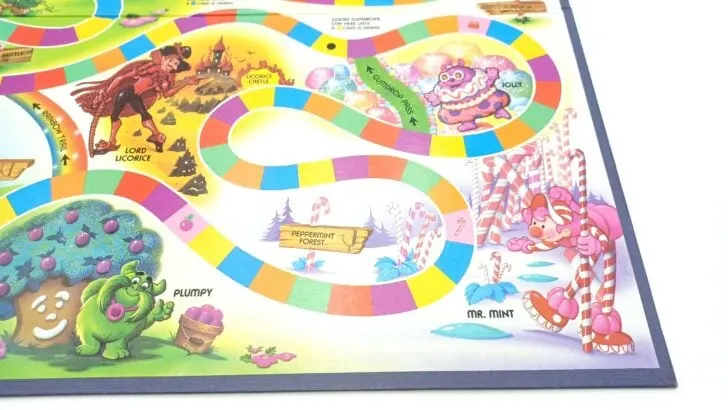
As you traverse the Gumdrop Mountain you meet Jolly the greeter of the area. Next comes Gramma Nutt who lives at the Peanut Brittle House. In the Lollypop Woods you meet Princess Lolly the daughter of King Kandy. Queen Frostine greets the players in the Ice Cream Sea. Finally before you reach the castle you visit with Gloppy the Molasses Monster.
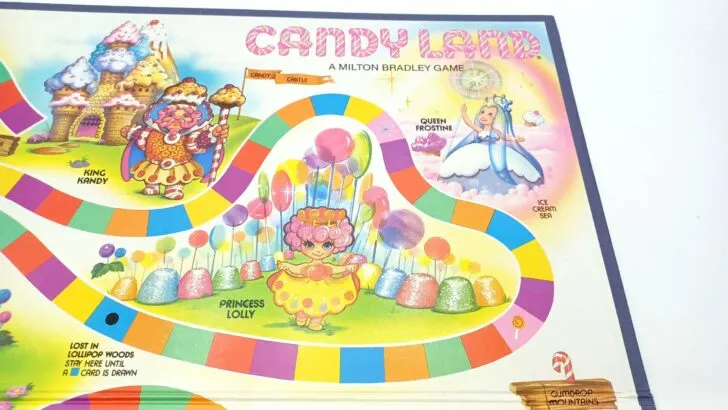
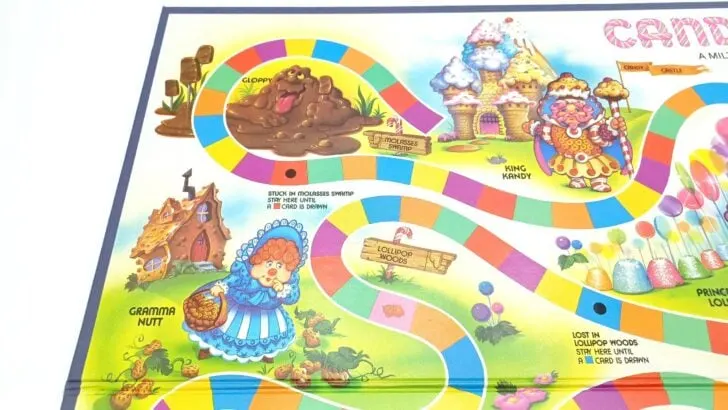
While these various character don’t really impact the gameplay in any noticeable way, the characters have brought a lot of the charm to the game. Many people have fond memories of these characters to this day. Some of them no longer exist in more recent versions of Candy Land. Several still remain key elements of the game almost 40 years later though.
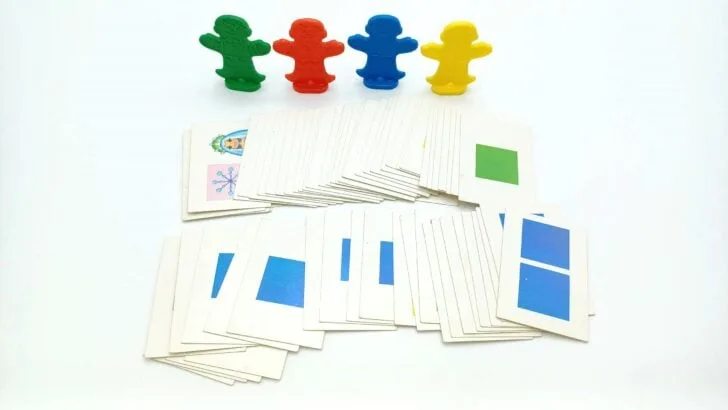
The 1984 version of feature four plastic gingerbread movers and 64 cards. The distribution of the cards are as follows:
- 8 blue
- 7 green
- 7 or 8 orange (hard to tell between red and orange on some cards)
- 8 purple
- 7 or 8 red
- 8 yellow
- 2 double blue
- 2 double green
- 2 double orange
- 2 double purple
- 2 double red
- 2 double yellow
- 6 special icons
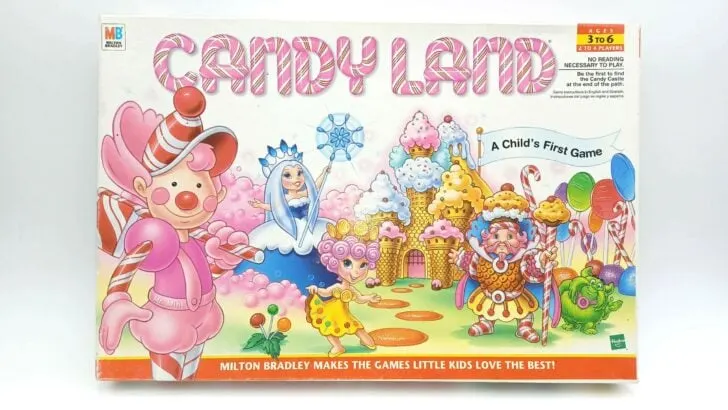
1998 A Rule Clarification and Tweaked Artwork
The 1984 version was the main version of Candy Land until an updated version was released in 1998. For the most part the 1980s and 1990s were a period in Candy Land’s history where things didn’t change much. The 1998 version of the game slightly tweaked the artwork. All of the characters and locations stayed the same though.
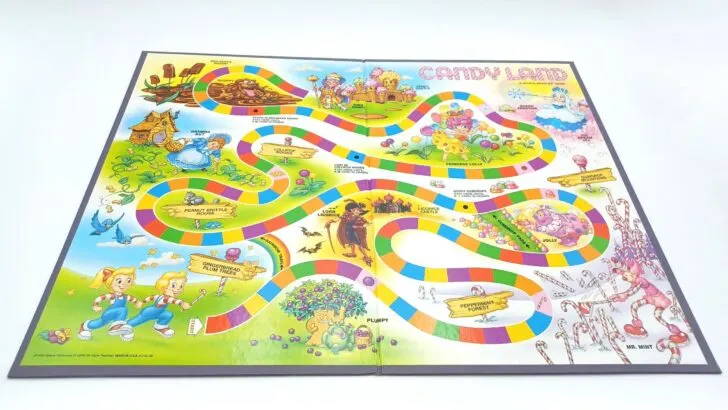
The biggest change in this version of the game addressed a rule disagreement families were having throughout Candy Land’s history. For many years people had arguments on whether you had to land exactly on the last space on the path in order to win Candy Land. The rules for most versions of the game were clear that you had to either land on the last space or move past it in order to win the game. A lot of people insisted that you could only win if you landed exactly on the last space though. Hasbro ended the debate with this version of the game. Instead of the last space being a single color, the gameboard was changed to make the last space multi-color so you could land on the space with any color card. Early editions of the 1998 version do not have this change.
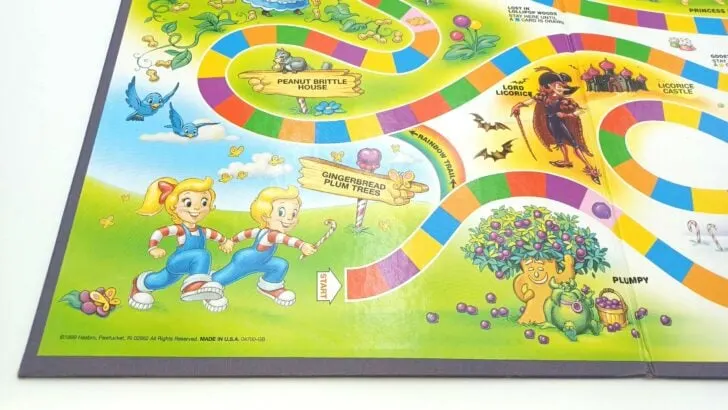
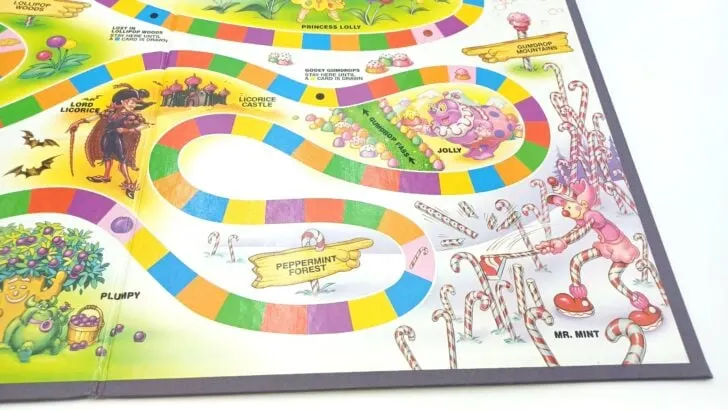
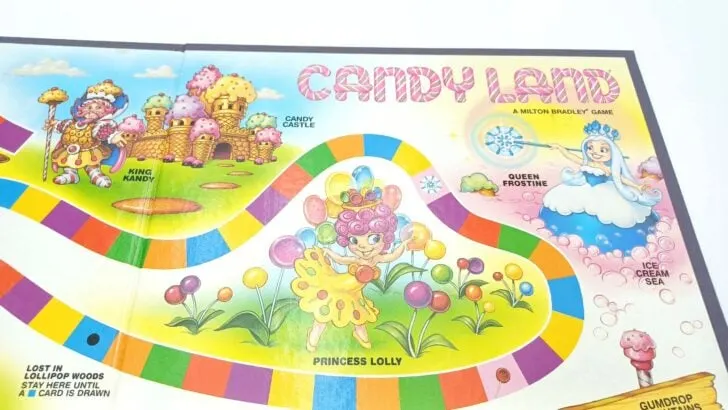
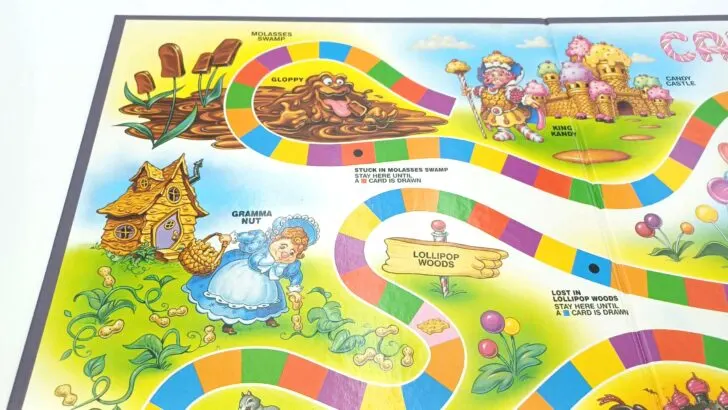
The card distribution of the 1998 version of the game is as follows:
- 8 blue
- 7 green
- 7 orange
- 8 purple
- 8 red
- 8 yellow
- 2 double blue
- 2 double green
- 2 double orange
- 2 double red
- 2 double yellow
- 6 special icons
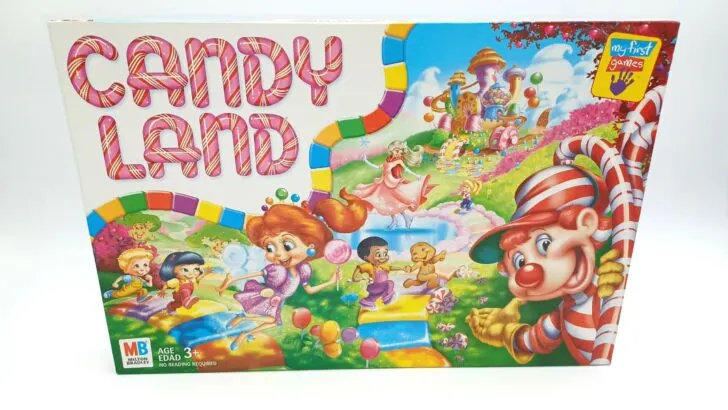
2004 The Disappearance of Plumpy
The 2004 version of Candy Land is actually one of the versions of the game that made the most changes in the game’s history. These changes impact both the gameplay and the theme/artwork.
Lets start with the changes to the gameplay. Until the 2004 version of Candy Land the board featured three black dots. Throughout Candy Land’s history these dots were given different names. Basically whenever you landed on one of these spaces, you were stuck on the space. The only way to continue moving was drawing a card that matched the space’s color. In the 2004 version of Candy Land these spaces became Licorice spaces. No longer are you stuck on the space until you draw the corresponding colored card. You only lose your next turn.
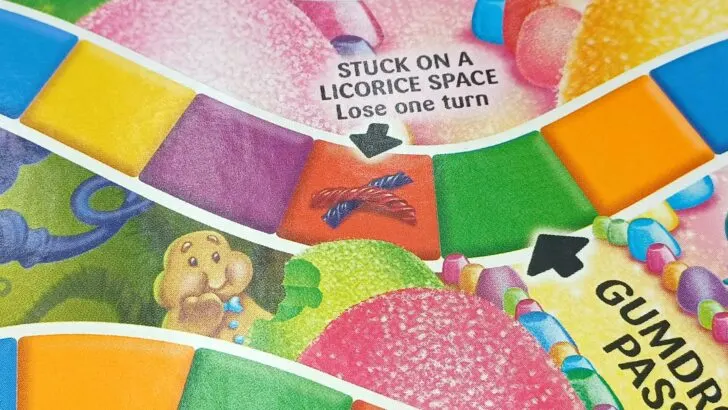
Most of the changes in the 2004 version of the game comes from the theme and artwork. The most obvious change is Plumpy is nowhere to be found. All traces of him and his Gingerbread Plum Trees have been removed from the game. His former trees are now just Gingerbread Trees. Additionally there was a shakeup in the royal court. Queen Frostine got a demotion to Princess Frostine, and Lolly lost her royal title of princess entirely. Jolly also got a massive design change turning into some sort of dinosaur/dragon. Finally there are now four children enjoying their stroll to the Candy Castle. This includes some much needed diversity in the children.
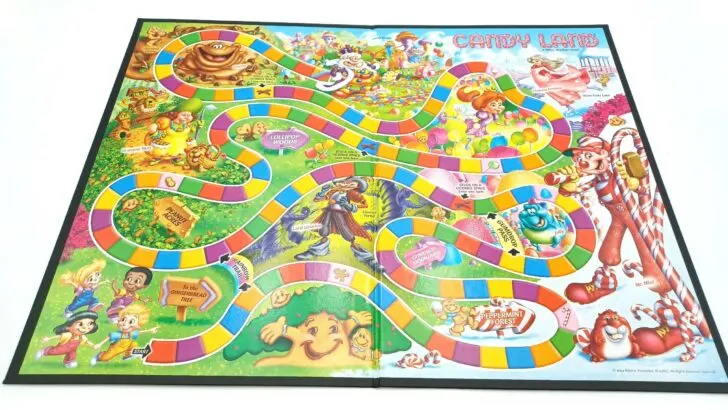
The locations of the candy kingdom received updates as well. Lord Licorice must have fallen on hard times because he now lives in the Licorice Forest instead of the Licorice Castle. The Peanut Brittle House has become Peanut Acres. The Ice Cream Sea has turned into the Snow Flake Lake. Finally Gloppy and his swamp have turned from molasses to chocolate.
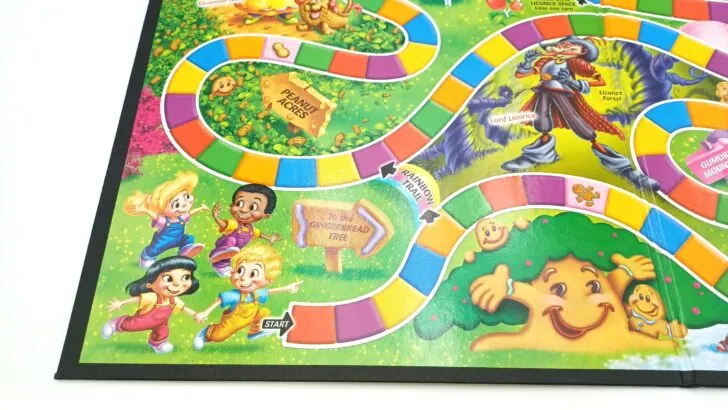
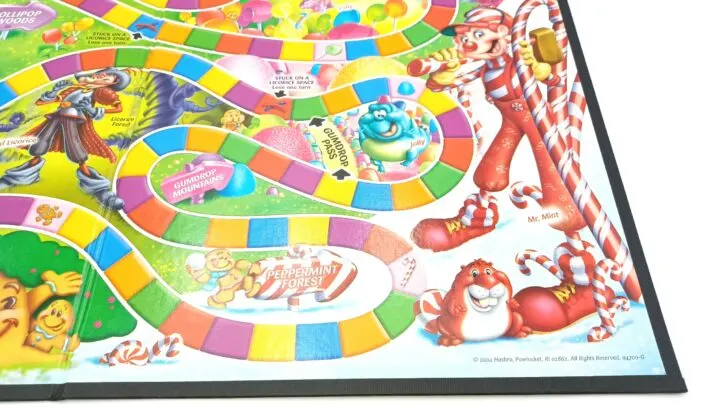
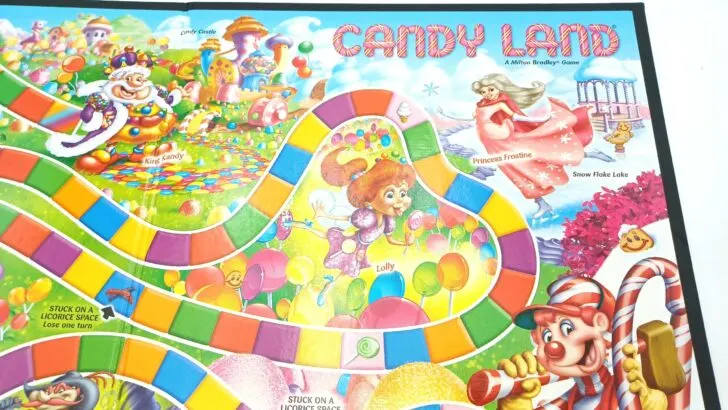
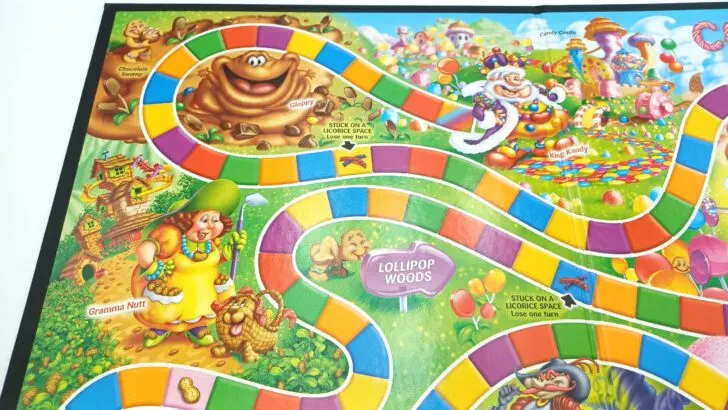
Outside of the changes to the gameboard, the components for the 2004 version of Candy Land are similar to older versions of the game. You still have four gingerbread movers and 64 cards.
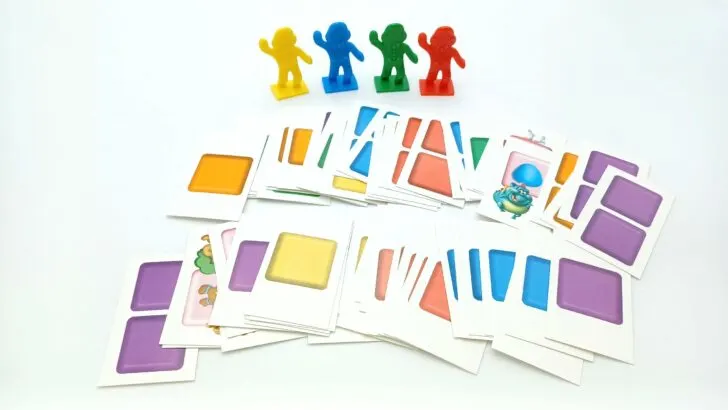
The distribution of the cards changed a decent amount as there are considerably more double color cards in this version of Candy Land.
- 6 blue cards
- 6 green cards
- 6 orange cards
- 6 purple cards
- 6 red cards
- 6 yellow card
- 4 double blue cards
- 3 double green cards
- 3 double orange cards
- 4 double purple cards
- 4 double red cards
- 4 double yellow cards
- 6 special icon cards
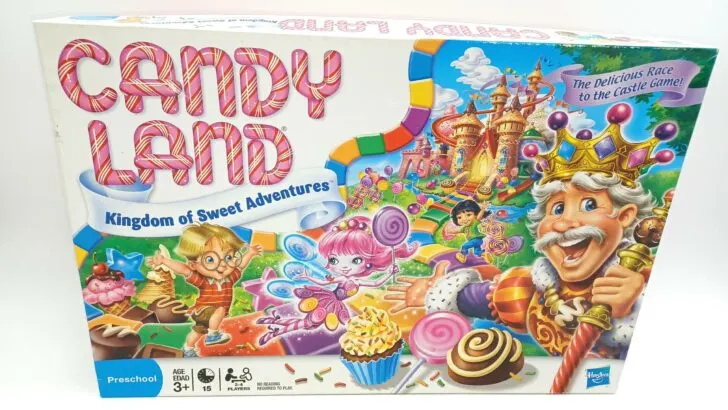
2010 The Departure of Beloved Characters
The 2010 version of Candy Land was another pretty big change in the history of the game.
There weren’t any significant changes to the gameplay, but there were some tweaks. The game added back a seventh special space close to the Candy Castle. The first shortcut path takes players considerably further along the path than it did in previous versions of the game. One of the licorice spaces were eliminated, so there are only two remaining on the board.
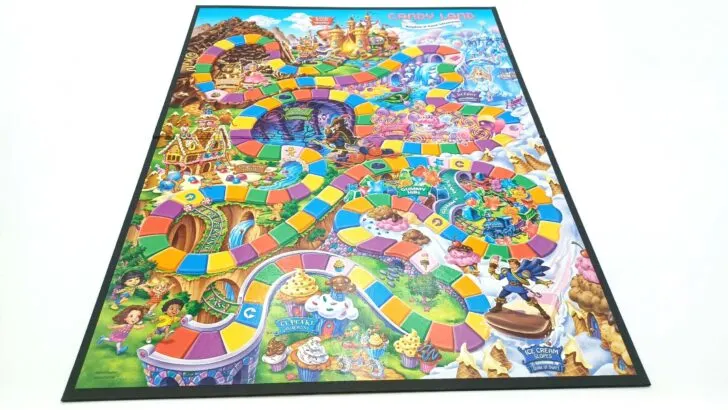
Most of the changes with this version of the game come in the theme and artwork. The 2004 version of the game got rid of Plumpy. The 2010 version gets rid of three more characters than have been in the game since 1984. Mr. Mint, Jolly and Gloppy were removed from the game. Gramma Nutt has also turned into Gramma Gooey. The Duke of Swirl ended up replacing Mr. Mint. The Duke of Swirl is in charge of an ice cream based ski resort where you ride ice cream boards. While some characters are gone, Princess Lolly did get her title of princess back.
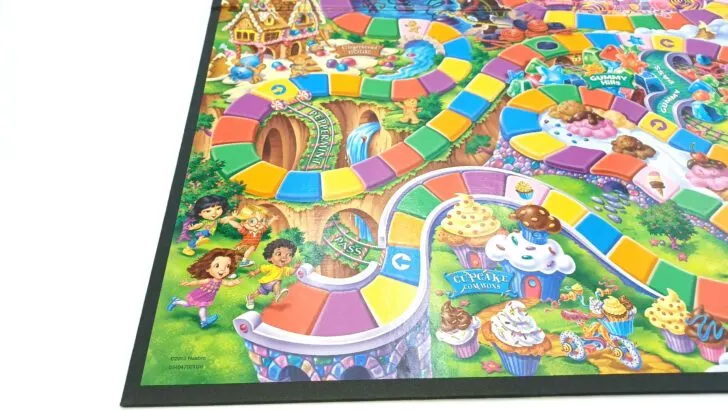
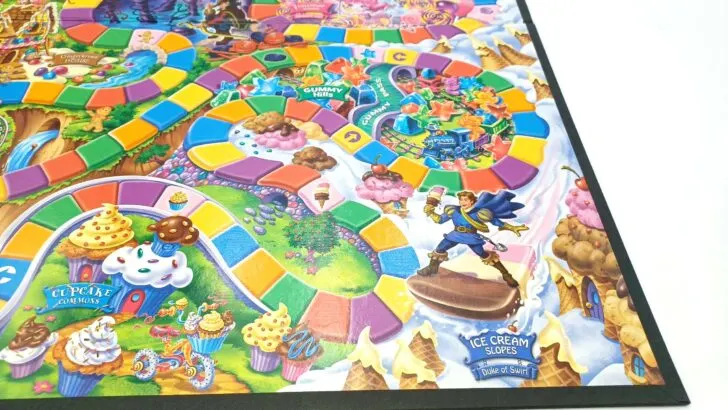
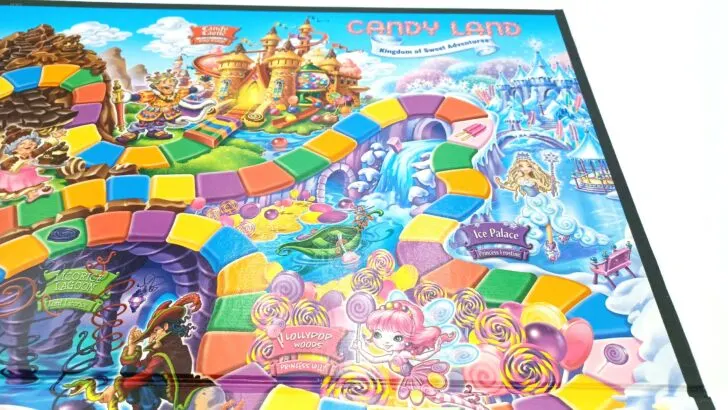
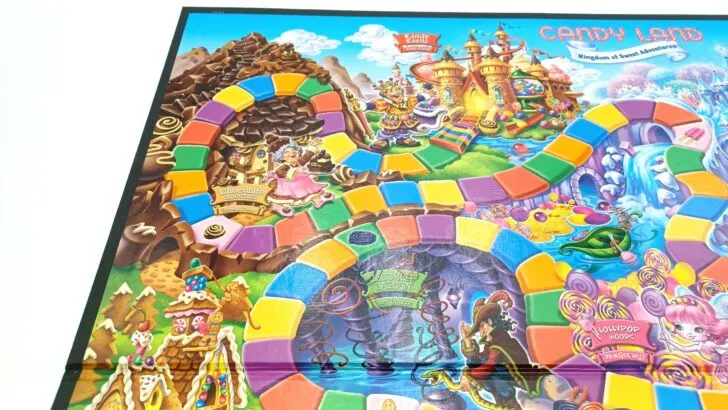
In addition to character changes, many of the locations in the game changed.
- Gingerbread Tree became the Cupcake Commons
- Peppermint Forest became the Ice Cream Slopes
- The Gumdrop Mountains became the Gummy Hills
- Peanut Acres changed into a Gingerbread House
- Lord Licorice’s Forest was moved later on the track. It also became the Licorice Lagoon
- The Snow Flake Lake became the Ice Palace.
- Finally the Chocolate Swamp became the Chocolate Mountain.
The components for the 2010 version of Candy Land didn’t change much from the previous version outside of the changes to the board mentioned above.
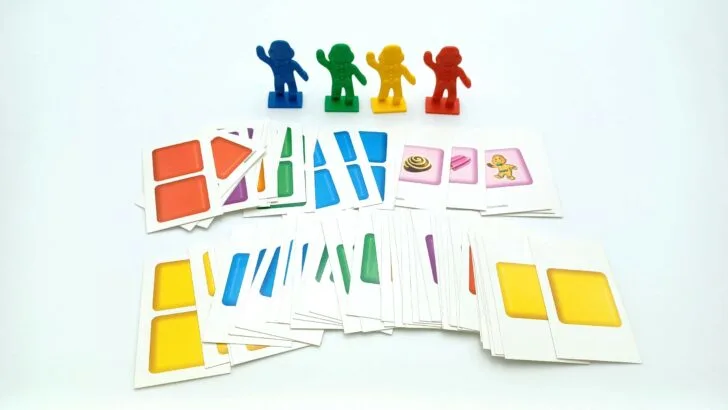
The distribution of the cards are as follows:
- 6 blue
- 6 green
- 6 orange
- 5 purple
- 6 red
- 6 yellow
- 4 double blue
- 3 double green
- 3 double orange
- 4 double purple
- 4 double red
- 4 double yellow
- 7 special icons
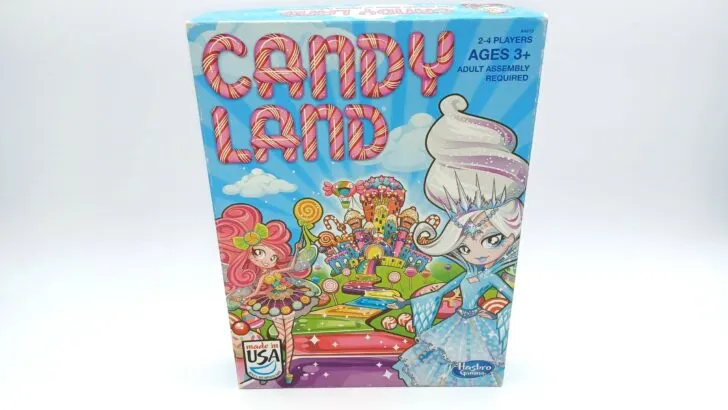
2013 A Completely Different Game
The 2013 version of Candy Land is interesting in that it is probably the most unique version in the entire history of the game.
Simply put 2013 was the first time in over 60 years that the gameplay drastically changed from the original version. Until 2013 the game always had players draw cards which would move them around the board. This all changed in 2013 when Hasbro ditched the cards and replaced them with a spinner. In theory this doesn’t really change the game a ton as all of the spaces are on the spinner in approximately the same ratio. I have no idea why they decided to ditch the cards though as that was a hallmark of the game and one of the things that it was most known for. This change was clearly not received well. The game ditched the spinner for the next version of Candy Land, and it would never return.
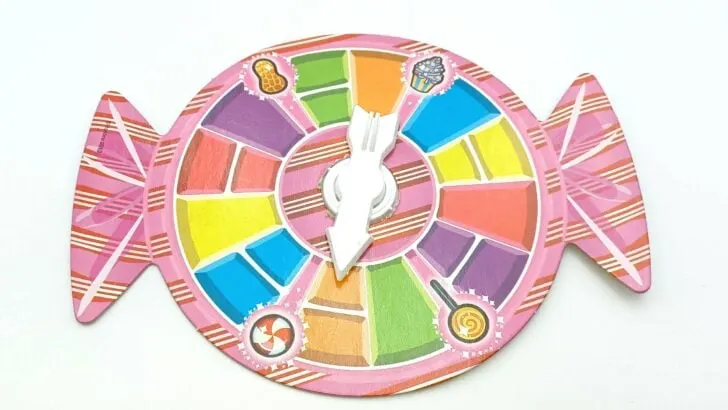
Another much smaller change to the gameplay is that players could no longer share spaces. Instead of sharing a space you move to the next space of the same color.
As for the theme and gameboard, the game returns to past versions in some ways, and changes things in other ways. The names of locations have been removed from the board entirely, but it features many of the same locations as previous versions of the game. Mister Mint and Nana Nutt are back while the Duke of Swirl disappeared as quickly as he arrived. Lord Licorice once again received a change of scenery as he now captains a licorice pirate ship.
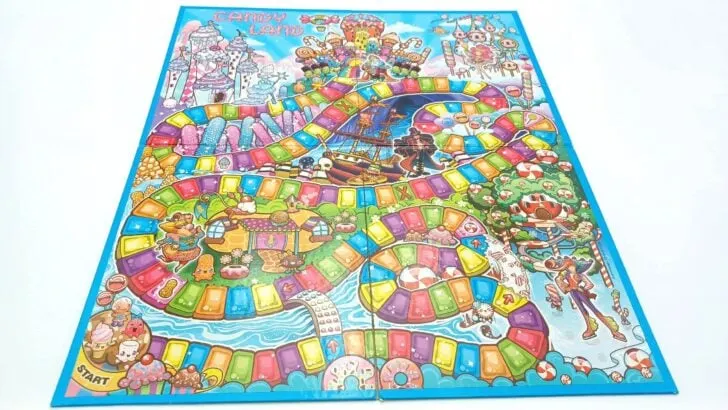
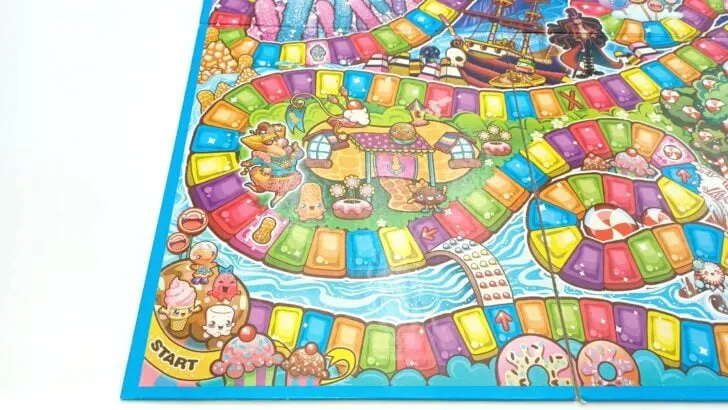
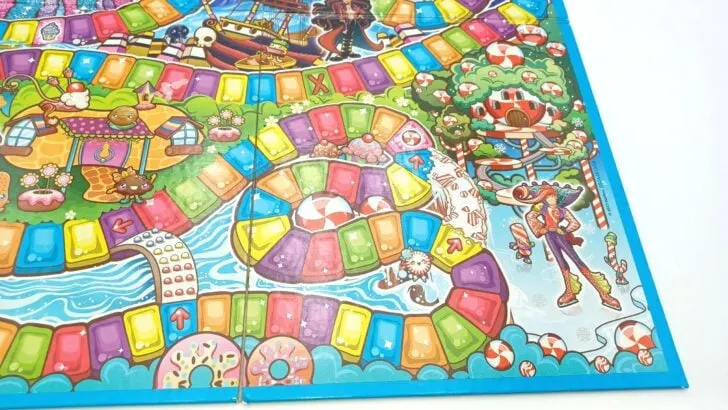
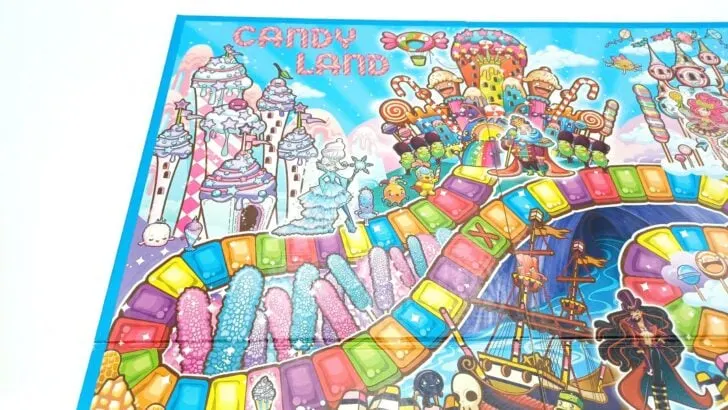
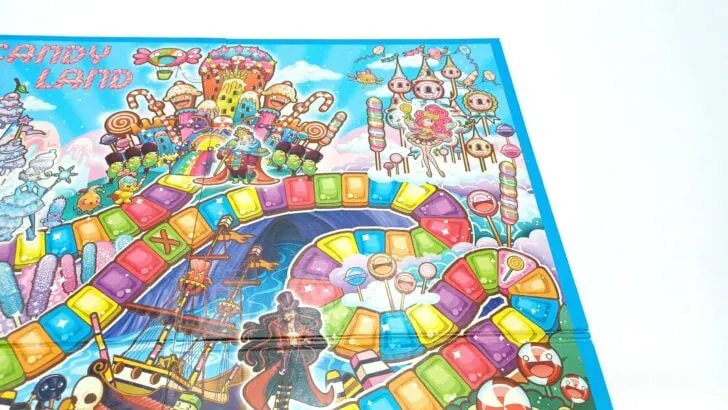
The components drastically changed from the previous version mostly due to the elimination of the cards. The box and board are also quite a bit smaller than previous versions. The gingerbread playing pieces were also replaced with various sweets.
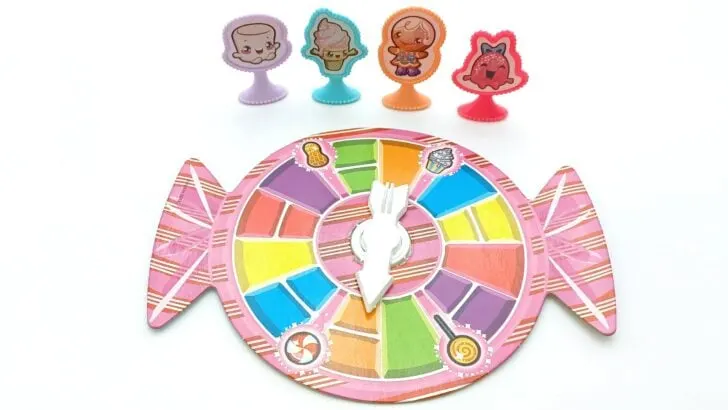
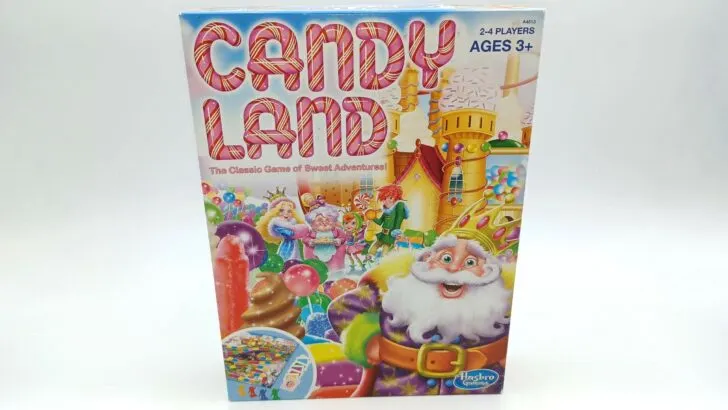
2014 A Return to the Original Candy Land
The 2013 version of Candy Land was a failure, and probably the most disliked game in the series’ history. It was so disliked that Hasbro released a new version of the game the next year. This version of the game was a return to the original game. The cards came back to the game and many of the characters and locations from previous versions returned as well.
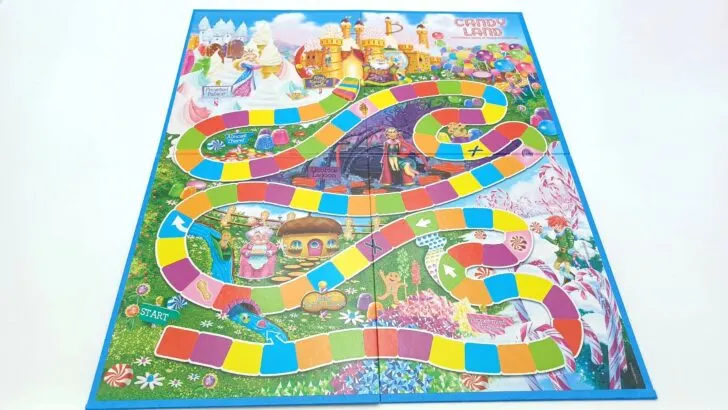
The only main difference in the rules is that you can’t land on the same space as another player. Therefore if you move to an occupied space, you will move to the next space of the same color. There are also only four special icon spaces on the gameboard.
As for the locations and characters, the game moves closer to the original design. The game features the common characters of Mr. Mint (although he now looks like an elf), Nana Nutt, Princess Lolly, Lord Licorice, and Princess Frostine. The Peppermint Forest returns along with Nana Nutt’s House, and the Licorice Lagoon. Two new locations were added as well: the Lollipop Palace and Frosted Palace.
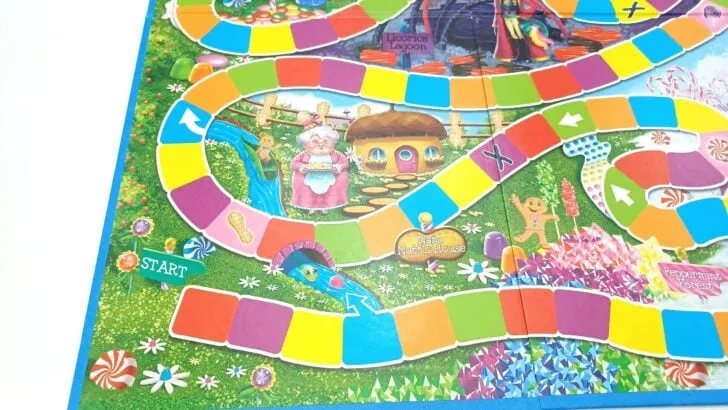
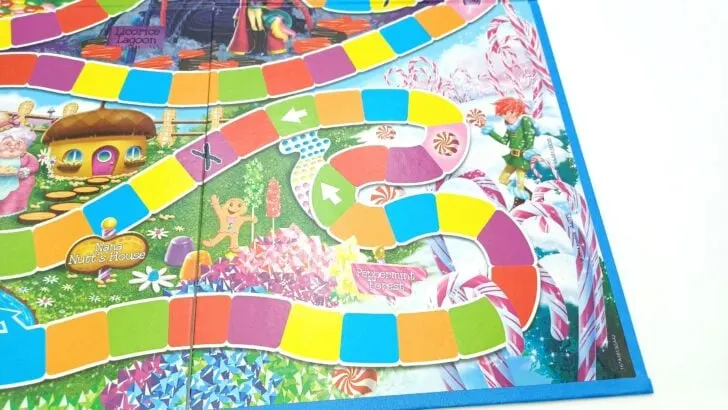
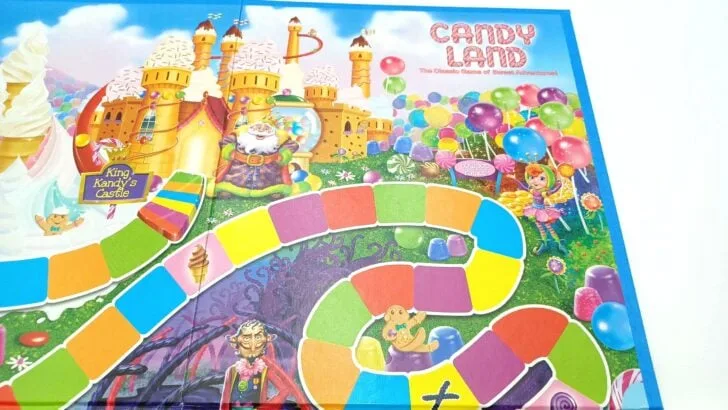
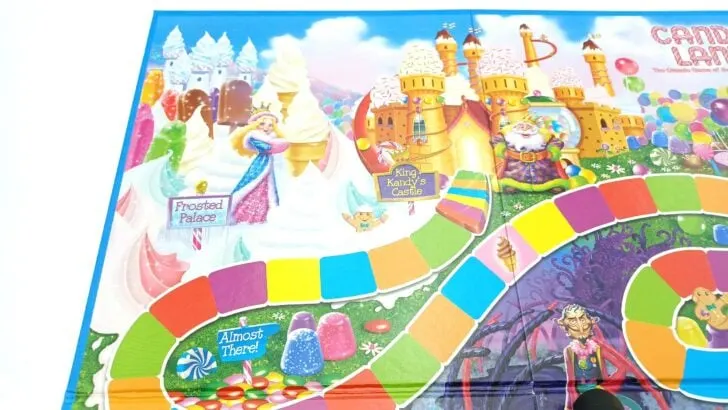
As for the components, many things return to how they were before the 2013 version. The box and gameboard are still smaller than earlier versions. The gingerbread playing pieces and cards are back though. The distribution of the cards did change quite a bit though as the game only has 44 cards.
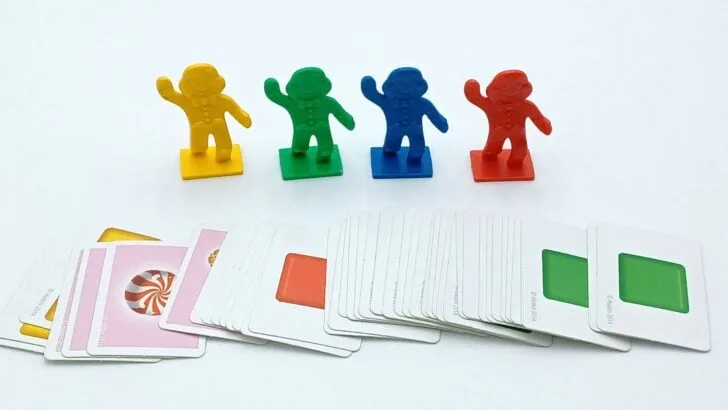
The distribution of the cards are as follows:
- 4 blue
- 4 green
- 4 orange
- 3 purple
- 3 red
- 4 yellow
- 2 double blue
- 3 double green
- 3 double orange
- 3 double purple
- 3 double red
- 3 double yellow
- 4 special icons
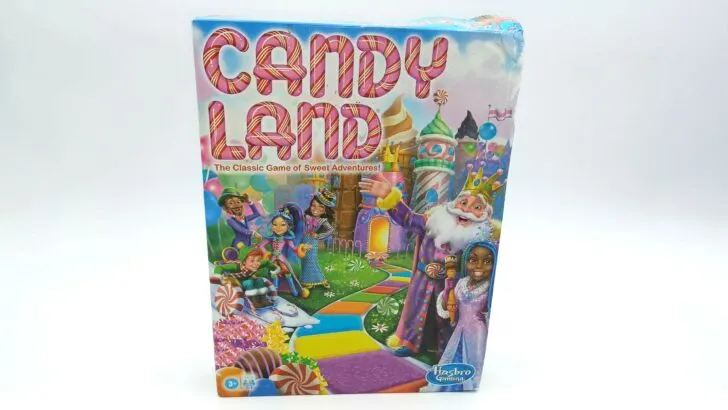
2021 The Newest Version of Candy Land
We have finally made it to the 2021 version of Candy Land. This is the most recent version of Candy Land at this time in the game’s history.
The 2021 version of Candy Land is actually pretty similar to the 2014 version of the game. The only real change to the gameplay is that it added one special icon back to the game for a total of five.
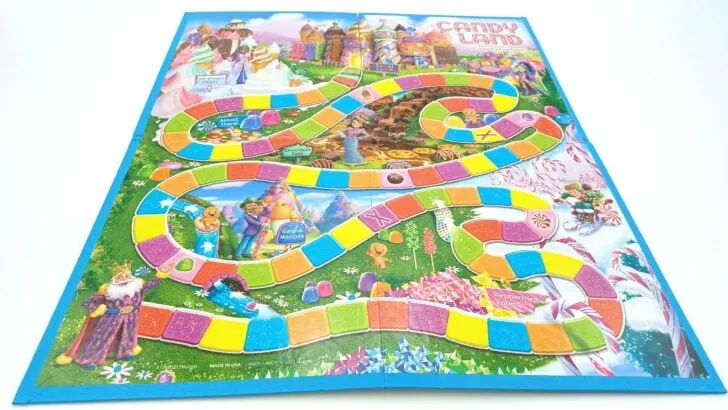
Most of the changes in the game come from the design of the board. Most of the locations are the same, but appear in different positions on the board. The Lollipop Palace is changed to Lollipop Lane, and the Frosted Palace became Ice Cream Peaks. The game does add one new location, Chocolate Falls. The characters have had a revamp. None of them are actually referred to by a name, even though I assume they are Mister Mint, Jolly, Princess Lolly and Princess Frostine. One interesting addition to this version of the game is the first character in a wheelchair. This is a fitting addition to the game as the game was originally designed for kids suffering from Polio. There were a lot of kids who contracted Polio that ended up in wheelchairs.
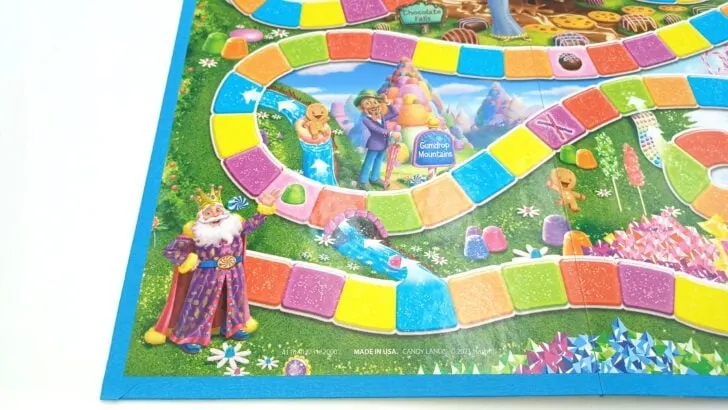
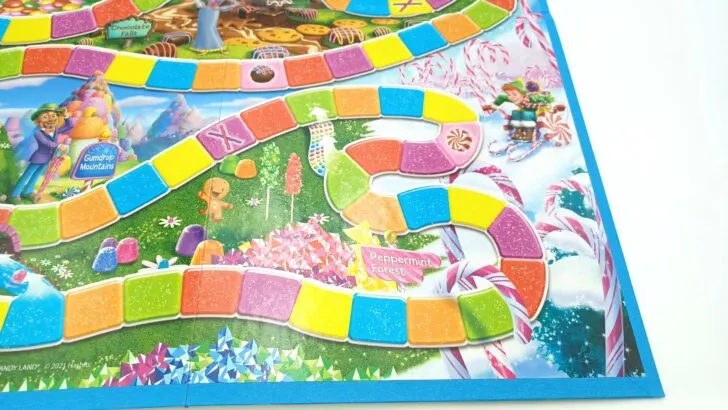
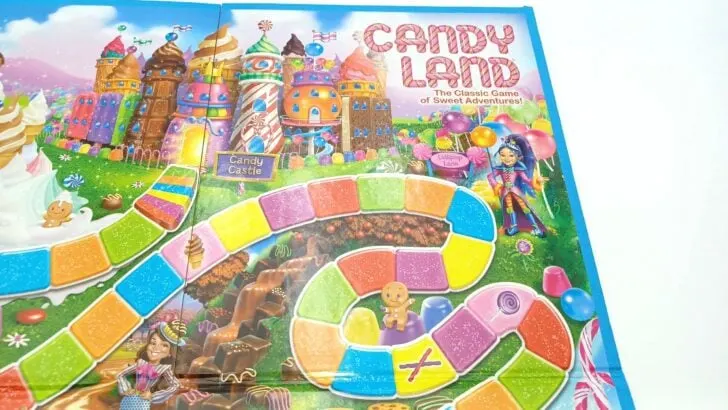
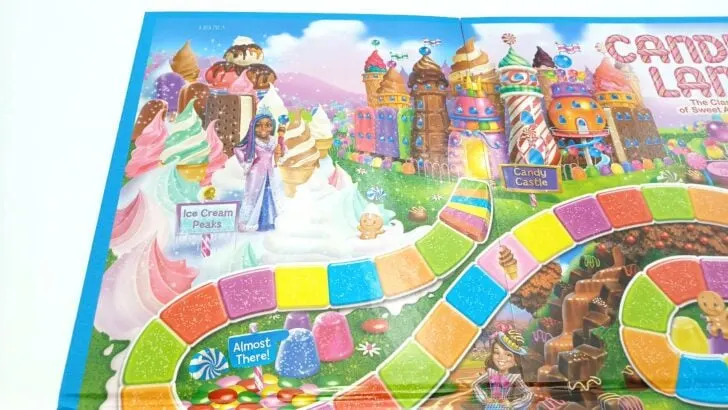
The components are very similar to the previous version of the game as well.
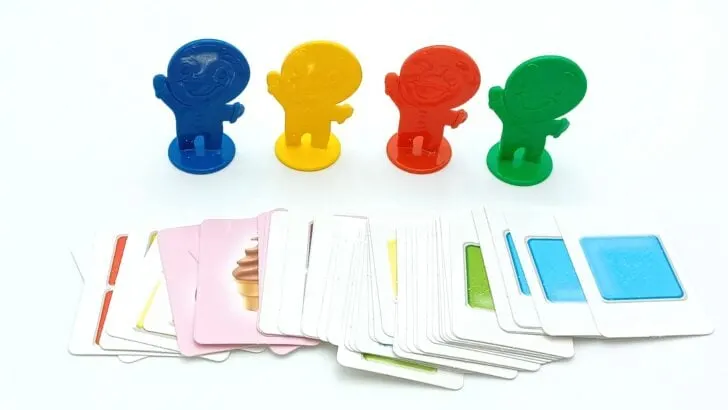
The distribution of the cards are as follows:
- 3 blue
- 4 green
- 4 orange
- 3 purple
- 3 red
- 4 yellow
- 3 double blue
- 3 double green
- 3 double orange
- 3 double purple
- 3 double red
- 3 double yellow
- 5 special icons

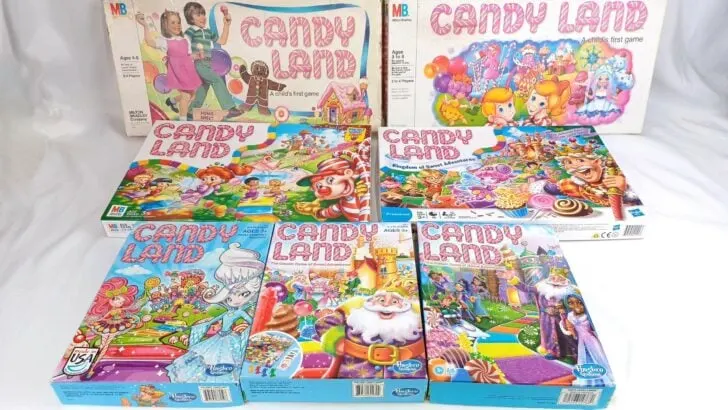
Candy Land Board Game: Rules and Instructions for How to Play - Geeky Hobbies
Saturday 7th of October 2023
[…] If you are interested in seeing how Candy Land has changed over the years and how they have affected the rules, check out our History and Timeline of Candy Land. […]